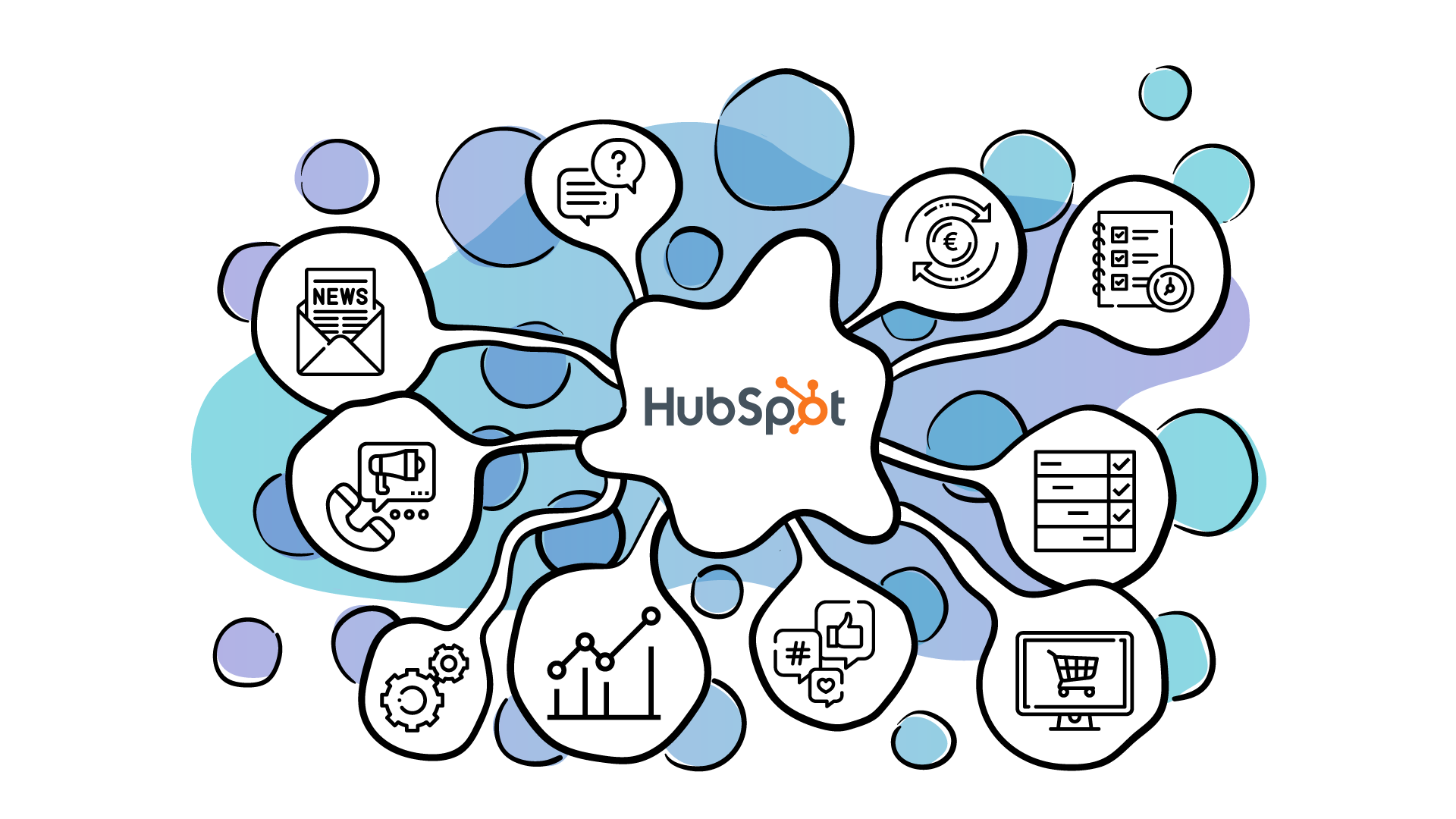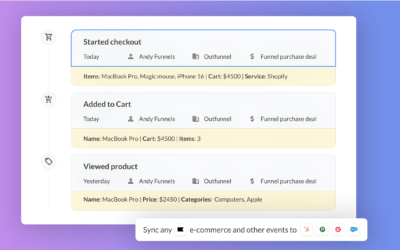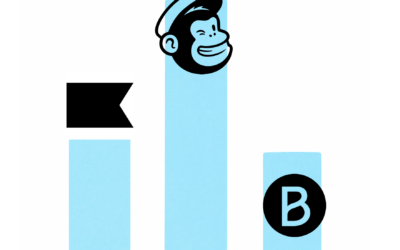Last updated: February 23, 2022
HubSpot offers a full platform of marketing, sales, customer service, and CRM software, so it may seem counterintuitive to be looking for HubSpot integrations with external tools.
But the truth is that these days, all great big software platforms acknowledge the power of letting customers pick and choose their own tools, especially when it comes to software that involves different departments and teams.
Perhaps you only use HubSpot CRM and don’t want to spend the big bucks on HubSpot’s marketing suite or sales sequences. Or maybe you’d like to integrate your already existing emailing and calling software with HubSpot. That’s where HubSpot integrations come into play.
What does HubSpot integrate with?
The HubSpot App Ecosystem can be overwhelming to navigate. It features over 1,000 integrations that work with different parts of the suite.
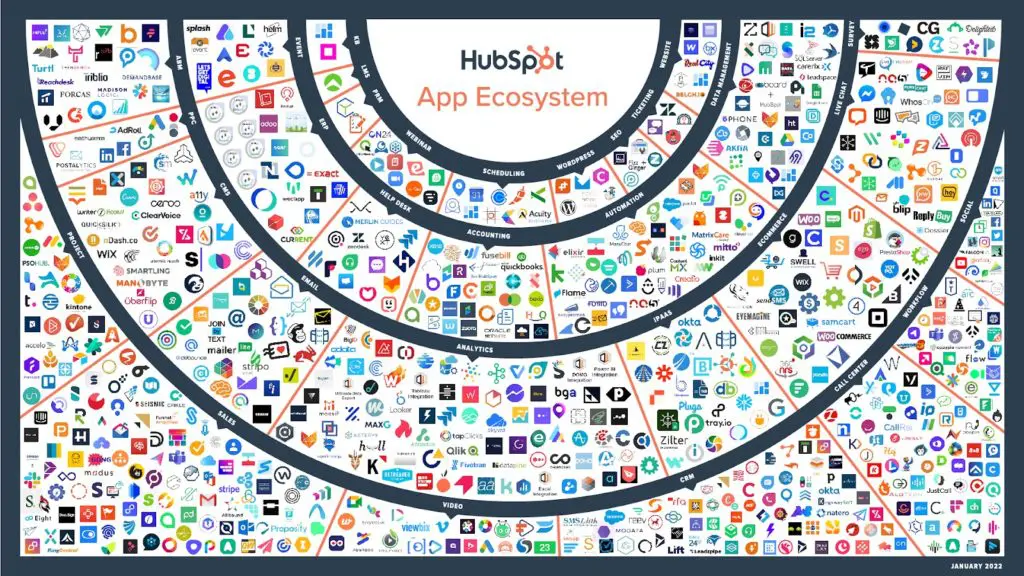
In this article we’ll review 8 of the best HubSpot integrations tactics that will help you increase sales productivity and streamline workflows.
Warning: this is not your average listicle featuring all the superficial connections with the most popular SaaS tools like Slack, Zapier, Eventbrite, Salesforce or Surveymonkey. In this article, we look at ways you can actually power up your sales and marketing productivity and drive more sales.
All it will take is automating the mundane and repetitive tasks, making sure nothing falls through the cracks and connecting the key sales enablement tools.
You ready? Time to get your HubSpot CRM powered up by:
- Automating lead capture with web form integrations
- Sending automated marketing messages with marketing automation integrations
- Syncing HubSpot & your inbox with email inbox integrations
- Accessing the power of LinkedIn outreach from within HubSpot
- Syncing conversations from social platforms with social media integrations
- Ensuring smooth calling with calendar, calling software, transcribing integrations
- Creating beautiful proposals and quotes with sales document software integrations
- Bonus for eCommerce businesses
Let’s jump right into the best HubSpot integrations list.
1. Automate your lead capture with web form integrations
Let’s start with the basics. You have to collect your new leads somewhere and web forms will do this for you. Just make sure that these integrate with HubSpot CRM and your database will get populated automatically.
There are several integrations that let you build forms and popups to your site and sync the data over to your HubSpot CRM. Your choice will have to depend on what tools you’ve used to set up your website.
Here, the top integrations we’ll highlight are Unbounce and, surprise-surprise, HubSpot’s own, free pop-up forms.
To help you choose between them, we’ll highlight the pros and cons of each below.
Lead capture with the Unbounce integration
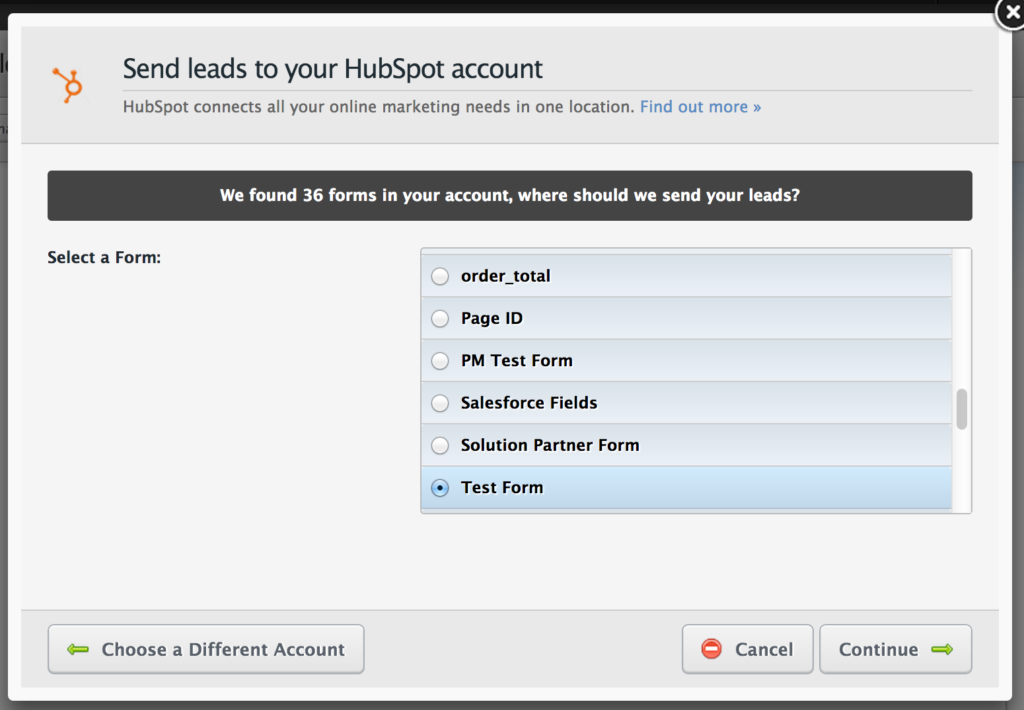
Unbounce is undoubtedly a very powerful conversion optimization tool, suitable for anyone from B2B to eCommerce. Lead capturing and conversion rate optimization (CRO) are their bread and butter.
The native Unbounce-HubSpot CRM integration helps make sure your HubSpot database gets automatically populated with lead info, like email addresses, collected in the custom forms.
Here’s what an honest review on the HubSpot ecosystem says about Unbounce:
Pros:
- Automated lead capture with forms, synced to your HubSpot CRM.
- Create beautiful landing pages, from a template or from scratch.
- Powerful features that help you test and optimize landing pages.
Cons:
- Some features may need a little bit of coding
- Unbounce’s forms are pretty simple, so may not be suitable for you if you have very specific needs or wish to heavily customize
P.S. Our own HubSpot CRM-Unbounce integration is coming soon. Follow the link to read more and sign up for early access: HubSpot-Unbounce integration.
Lead capture with HubSpot’s Forms
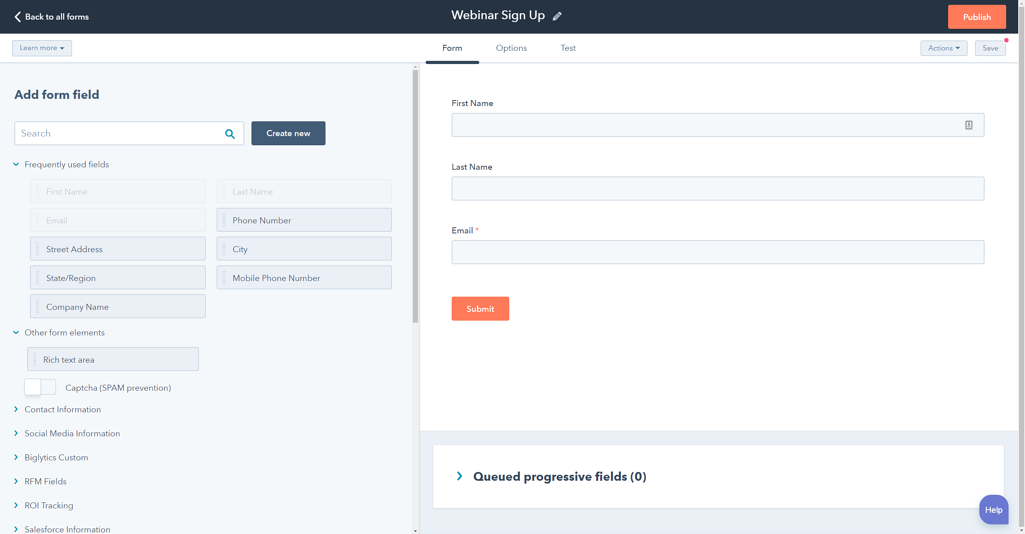
HubSpot offers a free pop-up forms tool. It may seem an obvious choice and indeed, many decide to get started with these. However, its free functionality is limited to just the forms, so you’ll have to set up landing pages separately.
Pros:
- Easy to set up forms that sync lead data to HubSpot CRM
- Free plan is sufficient for most marketing-specific form needs
Cons:
- Most style customization options are not available for free
P.S: If your website is built with WordPress or Wix, then you can consider the following integrations for syncing your leads into HubSpot CRM:
- Wix Forms-HubSpot intgeration
- Elementor Forms-HubSpot integration
- Contact Form 7-HubSpot integration
- Gravity Forms-HubSpot integration
2. Send relevant marketing messages & see marketing touchpoints in the CRM aka the key marketing-sales integrations (Mailchimp, ActiveCampaign, Sendinblue)
While HubSpot offers a full marketing suite, many find it too expensive and seek alternative options for getting their messages out. The biggest downside of doing so is that your marketing and sales data will be on separate platforms.
This is where integrations come into play. A truly useful integration between HubSpot and your marketing automation tool of choice will:
- keep your contact lists in sync to save you time otherwise wasted on managing contacts across platforms, and
- automatically record email opens, clicks, etc on the contact timelines in HubSpot, to help sales sell smarter.
There are a few HubSpot CRM integrations that will promise to align your marketing data with sales like this. We’ll highlight your options for two of the most popular marketing automation tools here: Mailchimp and ActiveCaampaign.
Connect HubSpot and Mailchimp to keep contact lists in sync and record marketing engagement in the CRM
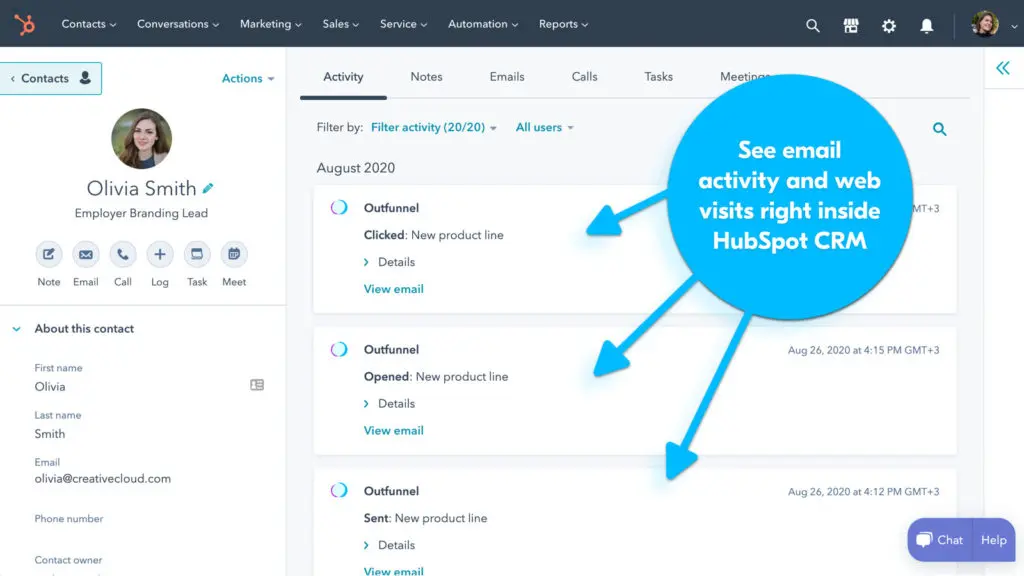
There are several integration apps available that offer HubSpot-Mailchimp integrations. Below, we’ll take a look at three options:
- Zapier’s HubSpot-Mailchimp integrations
- HubSpot’s Data Sync (part of Operations Hub)
- Outfunnel’s HubSpot-Mailchimp integration
Here’s a general overview of the three options:
HubSpot-Mailchimp integration options
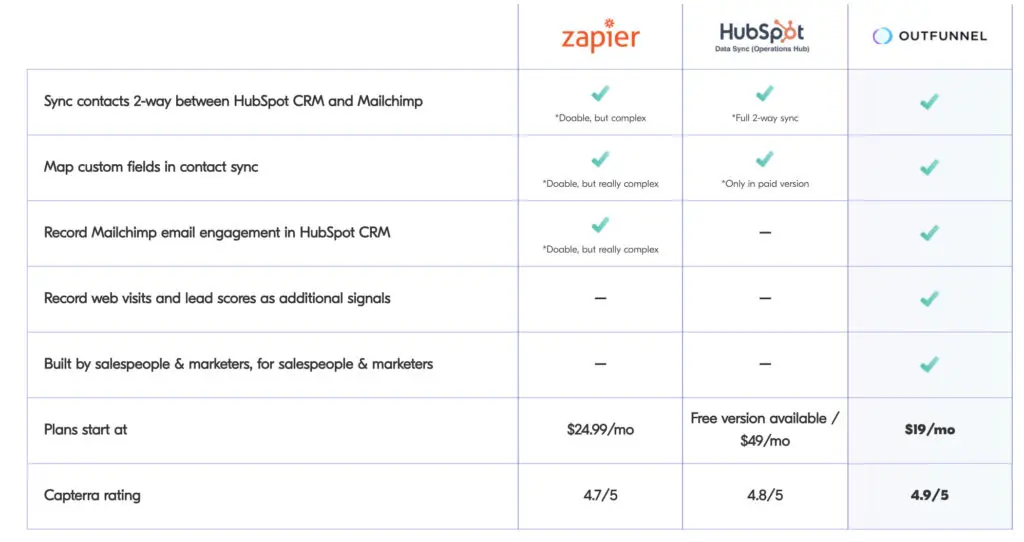
First off, Zapier. Unless you’ve been living under a rock, you’ve likely heard of Zapier’s automation tools that offer thousands of app connections. Well, both HubSpot and Mailchimp are among the apps Zapier is able to connect.
In fact, Zapier outlines a number of workflows you can build with their tool. Each of them is its own “if-this-then-that” automation.
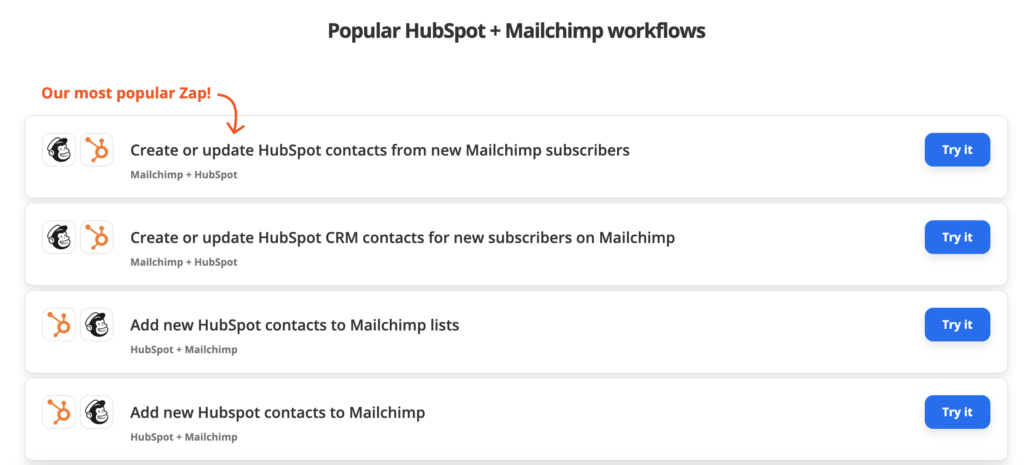
The main downside? Each of the flows has to be set up as a separate Zap, and as such, each will count separately towards your subscription plan. Additionally, while the contact sync Zaps are not too complicated to set up, recording email engagement in HubSpot is a separate topic. While theoretically possible, the setup is super complex and again, needs a separate workflow for each type of engagement you wish to record (email opens, clicks, unsubscribes, etc).
Secondly, HubSpot’s Data Sync app (a part of HubSpot’s Operations Hub) is built for keeping HubSpot and Mailchimp contacts in 2-way sync. You can match First Name, Last Name, and all your custom merge fields in Mailchimp as well, although you do need to upgrade to Operations Hub Starter plan or higher to match custom fields.
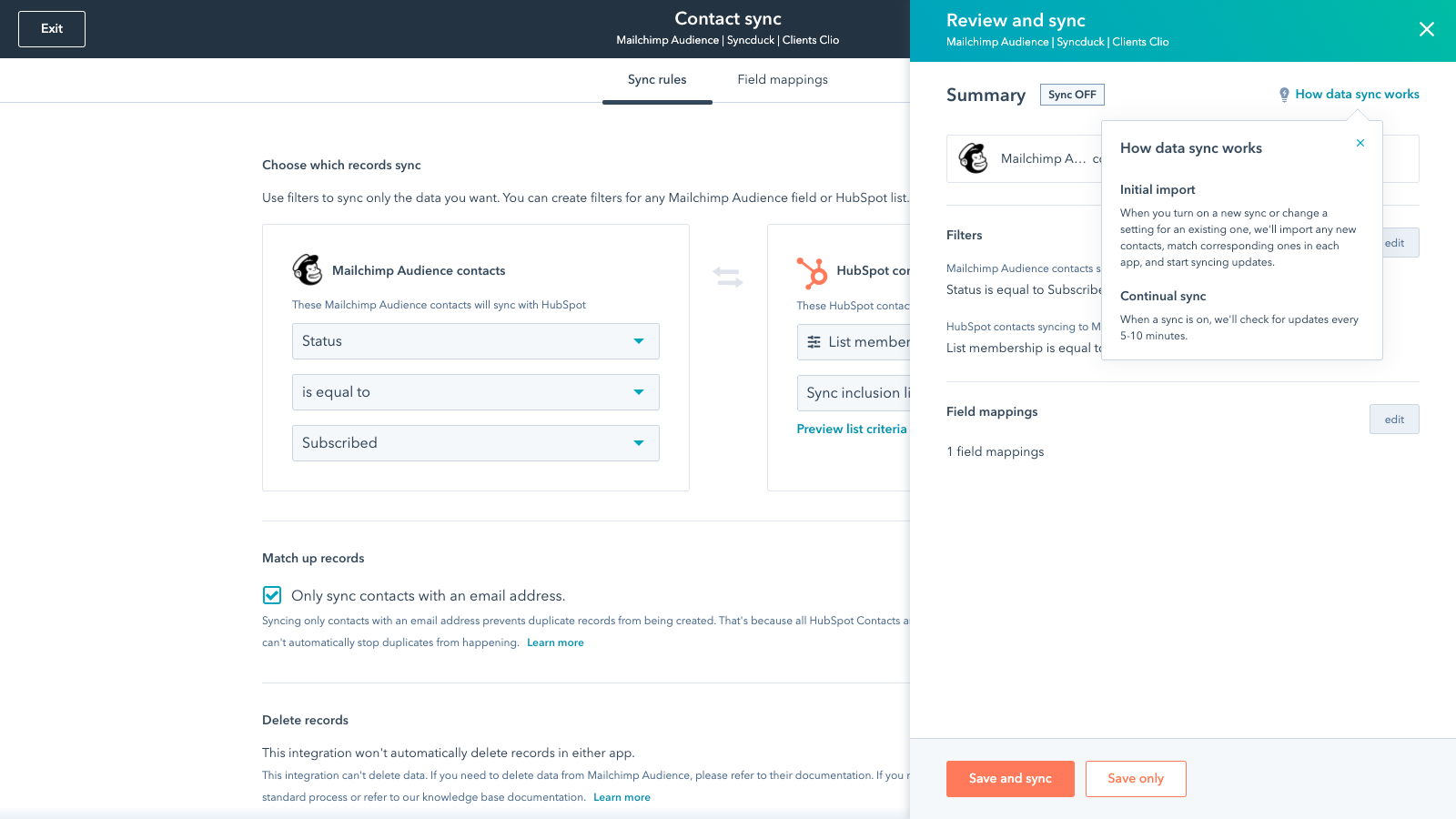
The main downside of HubSpot’s Data Sync app? It does not record Mailchimp email engagement in HubSpot. So, while contact lists are kept in sync, your salespeople will not be able to see what marketing emails your contacts have received and engaged with.
Last but not least, let’s take a look at Outfunnel’s HubSpot-Mailchimp integration. It offers both 2-way contact sync between the tools and recording marketing engagement in HubSpot. The best part? As Outfunnel is the only integration platform designed for sales-marketing connections, the setup is super easy and doesn’t require any expert skills or knowledge.
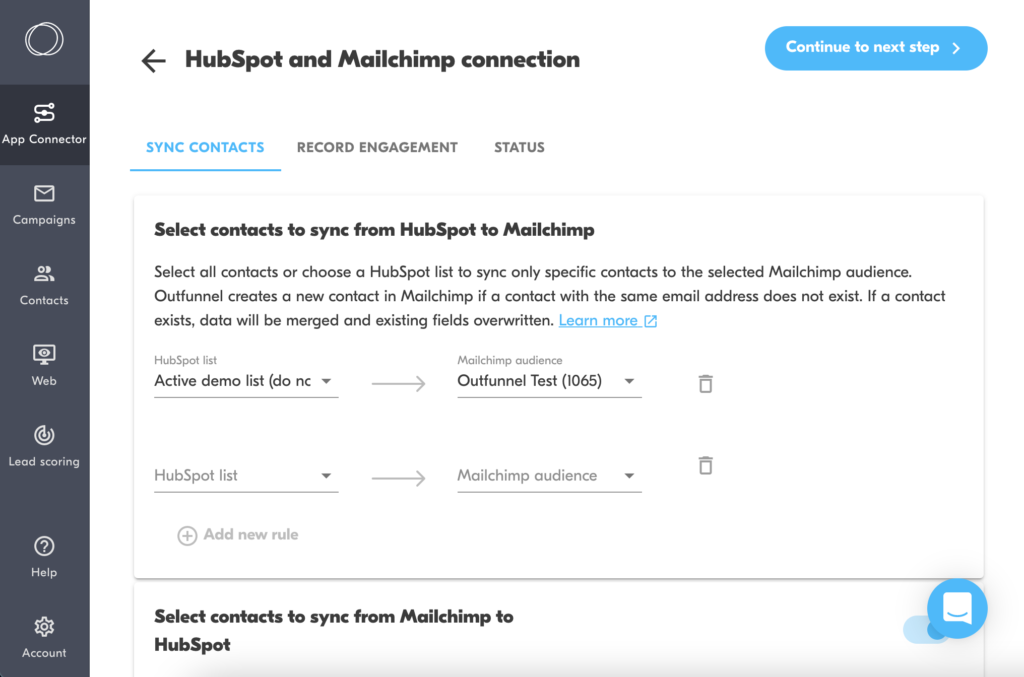
The main downside? Unlike Zapier and HubSpot’s Operations Hub, you probably don’t use Outfunnel already, meaning it’s a new tool you need to add to your tech stack to make use of the integration. Thankfully, Outfunnel’s pricing plans are very affordable, starting at just 19USD.
Send marketing emails with ActiveCampaign, and connect it with HubSpot to keep data in sync across the tools
A number of tools offer HubSpot-ActiveCampaign integrations. In this section, we’ll take a look at three of them:
- Zapier’s HubSpot-ActiveCampaign integrations
- HubSpot’s Data Sync (part of Operations Hub)
- Outfunnel’s HubSpot-Activecampaign integration
The TL;DR version:
HubSpot-ActiveCampaign integration options
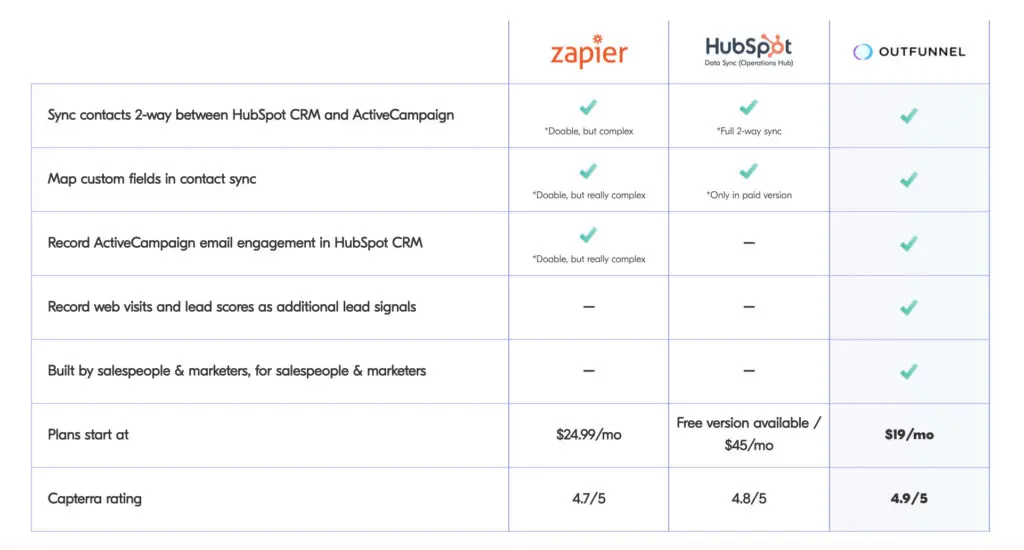
First, let’s take a look at what Zapier offers. On Zapier’s website, you can see a number of HubSpot-ActiveCampaign Zaps that you can set up. As with all Zapier integrations, each Zap is its own “if-this-then-that” automation.
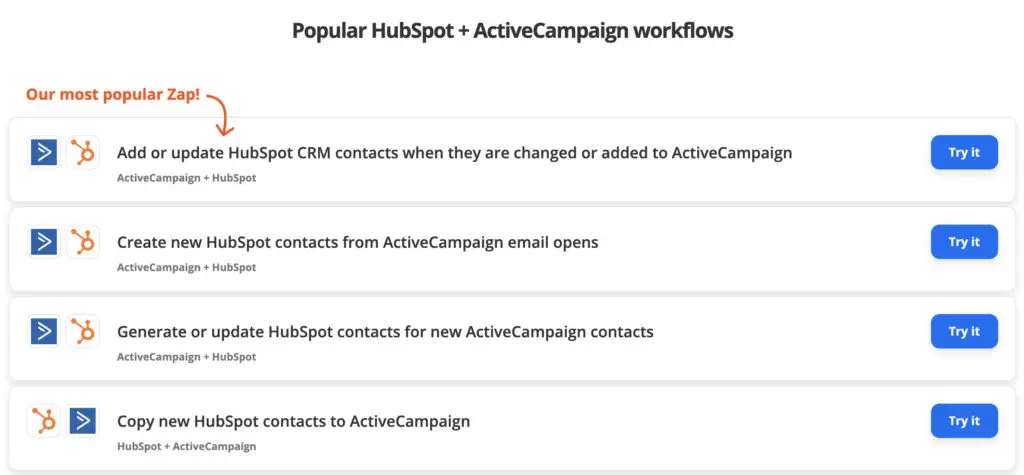
The main disadvantage of Zapier in this context? Each of the Zaps has to be set up separately, and as such, each of them will count towards your subscription plan (read: this gets expensive quite fast). Additionally, while the contact sync workflows are pretty straightforward to set up with Zapier, recording email engagement in HubSpot is on another level. While it is theoretically possible, the setup is super complex and again, needs a separate workflow for each type of engagement you wish to record (email opens, clicks, unsubscribes, etc).
Secondly, HubSpot’s Data Sync app for ActiveCampaign (a part of HubSpot’s Operations Hub) is designed to keep HubSpot and ActiveCampaign contacts in 2-way sync. The free version comes with out-of-the-box default field mapping, but if you want custom field mapping, you need to upgrade to Operations Hub Starter plan or higher.

The main downside of HubSpot’s Data Sync app for ActiveCampaign? It does not let you record ActiveCampaign email engagement (e.g. email sends, opens, clicks, etc) in HubSpot. So, while contact lists are kept in sync, your salespeople will lack context on what marketing emails your contacts have received and engaged with.
And finally, let’s take a look at Outfunnel’s HubSpot-ActiveCampaign integration. You can use it for both contact sync between the tools as well as recording marketing engagement in HubSpot.
As Outfunnel is the only 3rd-party integration tool designed for sales-marketing integration, the setup is quick, easy, and doesn’t require any special expertise or coding skills.
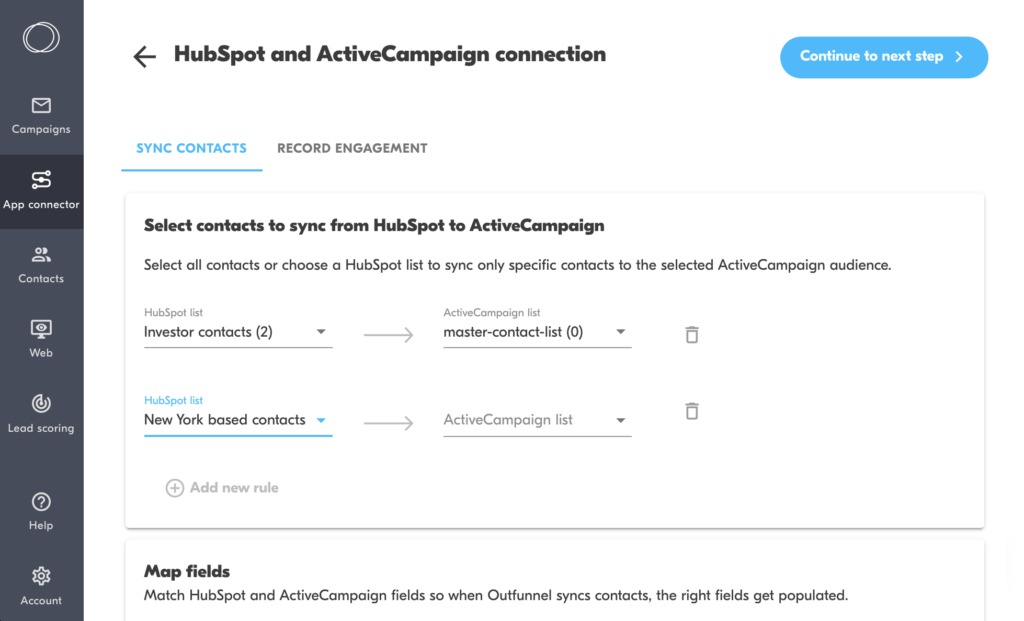
The biggest downside of Outfunnel? As you probably don’t use Outfunnel already, it’s a new tool that you need to add to your tech stack. Thankfully, Outfunnel’s pricing plans are very affordable, starting at just 19USD.
Send automated marketing campaigns with Sendinblue, and connect it with HubSpot to keep data in sync across the tools
Again, several platforms offer HubSpot-Sendinblue integrations. In this section, we’ll take a look at three of them:
- Zapier’s HubSpot-Sendinblue integrations
- HubSpot’s Data Sync (part of Operations Hub)
- Outfunnel’s HubSpot-Sendinblue integration
The TL;DR version:
HubSpot-Sendinblue integration options
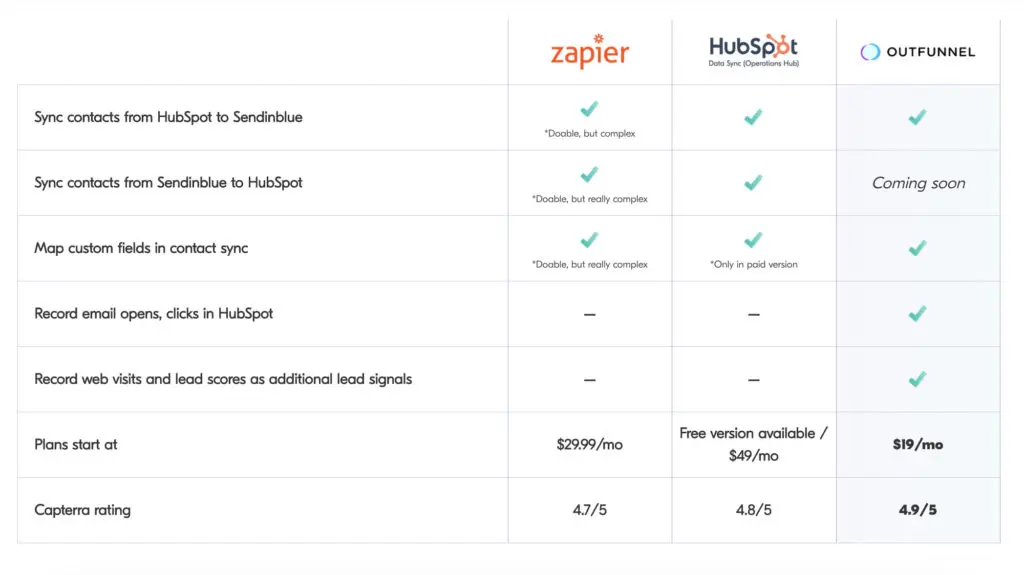
First, let’s see the most popular automations that Zapier offers. On Zapier’s website, you can see a number of HubSpot-Sendinblue Zaps that you can set up. As with all Zapier integrations, each Zap is its own “if-this-then-that” automation.
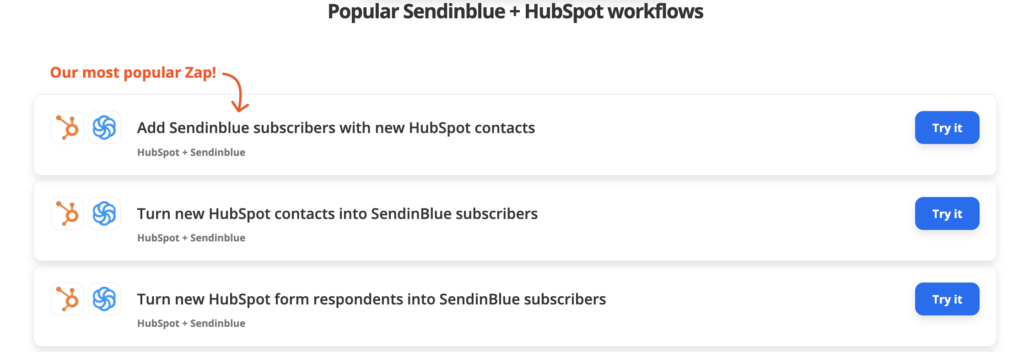
The main disadvantage of Zapier for integrating Sendinblue and HubSpot? Each of the Zaps has to be set up separately, which means each and every one of them will count towards your subscription plan (read: this gets expensive fast). Also, while the contact sync workflows are pretty straightforward to set up with Zapier, recording email engagement in HubSpot is on another level. While it is theoretically possible, the setup is super complex and again, needs a separate workflow for each type of email engagement you want to be recorded (email opens, clicks, unsubscribes, etc). No wonder many are looking for Zapier alternatives these days!
Secondly, HubSpot’s Data Sync app for Sendinblue (a part of HubSpot’s Operations Hub) is designed to keep HubSpot and Sendinblue contacts in sync. The free version comes with out-of-the-box default field mapping, but if you want custom field mapping, you need to upgrade to Operations Hub Starter plan or higher.

The main downside of HubSpot’s Data Sync app for ActiveCampaign? It does not let you record ActiveCampaign email engagement (e.g. email sends, opens, clicks, etc) in HubSpot. So, while contact lists are kept in sync, your salespeople will lack context on what marketing emails your contacts have received and engaged with.
Last but definitely not least, let’s consider Outfunnel’s HubSpot-Sendinblue integration. It syncs contacts between the tools and records email opens, clicks, unsubscribes for contacts HubSpot.
As Outfunnel is the only 3rd-party integration tool designed for sales-marketing integrations, the setup is quick, easy, and doesn’t require any special expertise or coding skills.
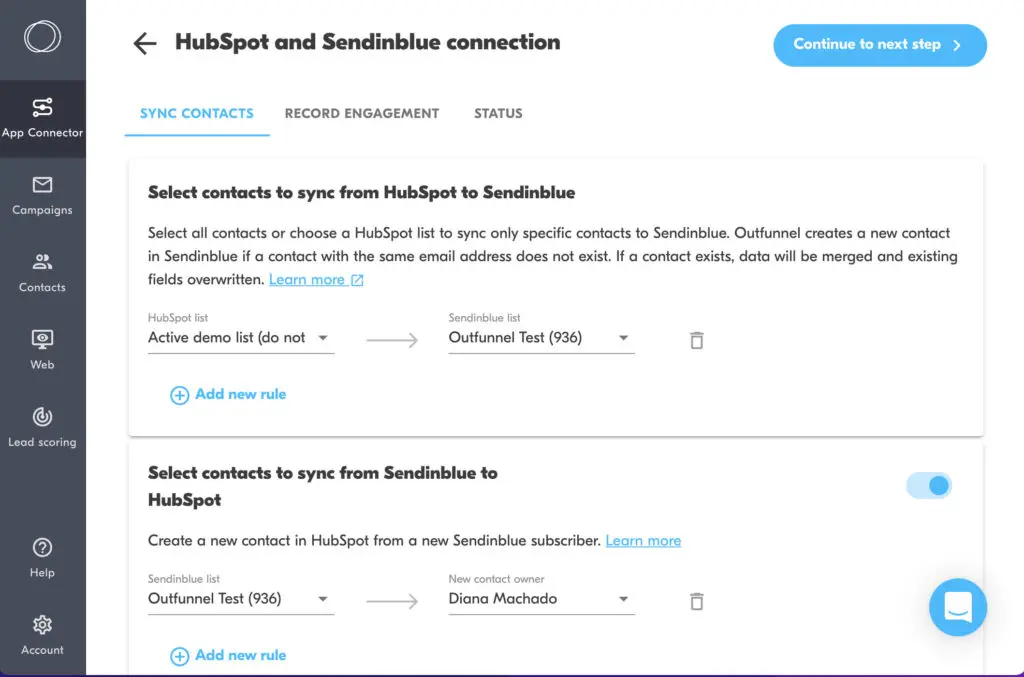
The biggest downside of Outfunnel? Unless you use Outfunnel already, it’s a new tool that you need to add to your tech stack. However, it’s worth noting that, Outfunnel’s pricing plans are very affordable, starting at just 19USD per month.
3. Sync HubSpot with your inbox (but not all of it) aka HubSpot CRM email integrations (Gmail, Outlook)
Integrating HubSpot with your inbox allows you to easily log emails in the HubSpot CRM.
Pro tip: only log sales emails, not all email activity. In this way, you can avoid pulling in unnecessary info and spamming your contact pages.
Email inboxes, integrated with HubSpot CRM
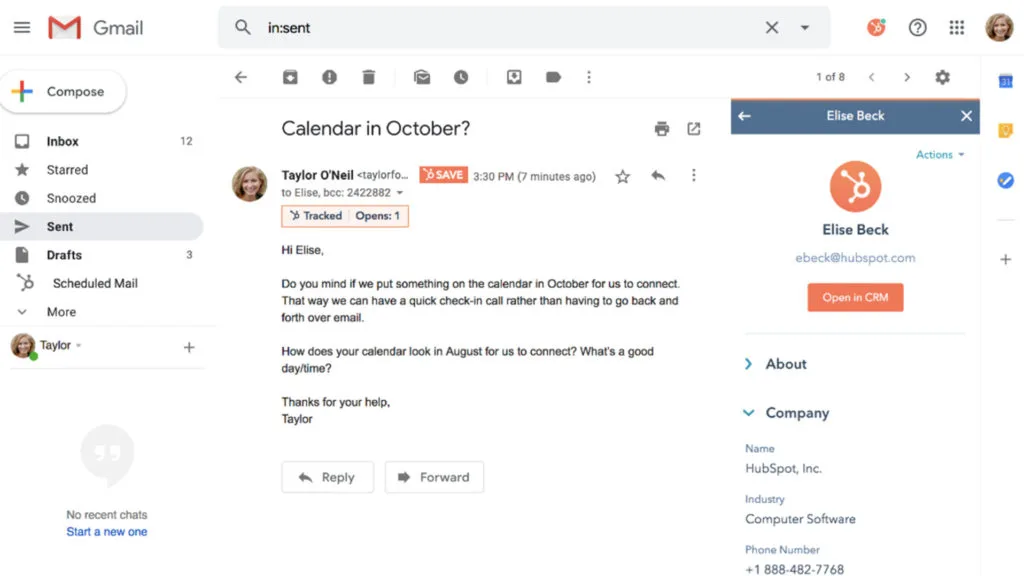
The Gmail and Outlook integrations work very similarly, so we’ll review their pros and cons together.
Pros:
- Keep track of your sales emails in HubSpot CRM
- Use key HubSpot features in your inbox
Cons:
- Email open and click info is only available to paid tiers of HubSpot Sales, which can become pricey
- Contacts are not synced between your inbox and CRM
4. Access the power of LinkedIn outreach from within HubSpot
LinkedIn has become a powerful outreach tool for sales reps, a close second to email. The Sales Navigator is LinkedIn’s sales management tool that makes it easy to find, contact and stay up to date with your contacts. With the Sales Navigator, you can message people outside of your network, do advanced searches, save leads and create custom account lists.
Now, pair that with HubSpot CRM, and what do you get? All the powerful features, inside HubSpot CRM.
Use the LinkedIn Sales Navigator inside HubSpot CRM
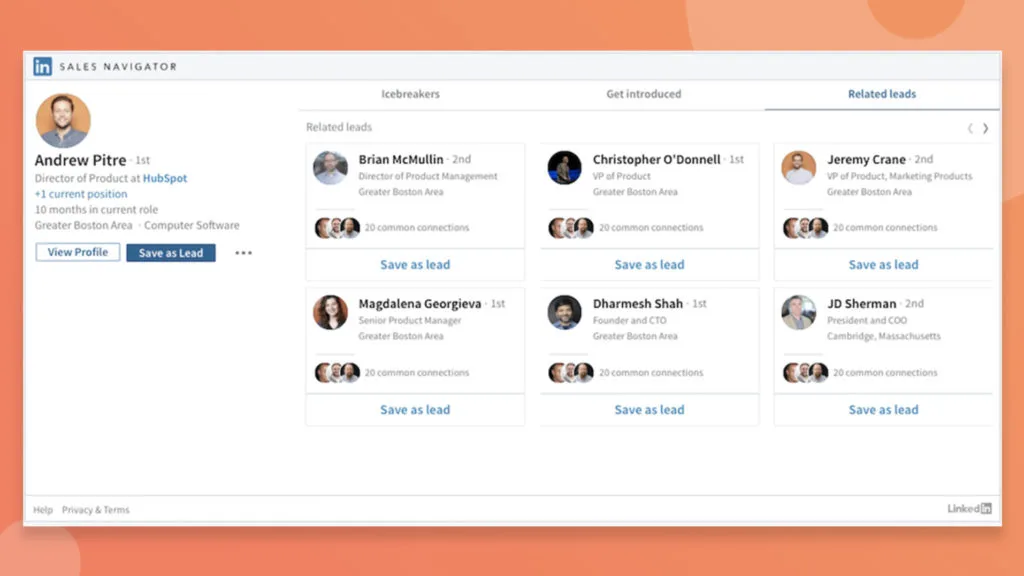
In short, here are the pros and cons of the LinkedIn Sales Navigator-HubSpot CRM integration:
Pros:
- Send InMail directly from the contact record in HubSpot CRM.
- View shared connections, experiences, and interests.
- See key info on your company records to better understand your key accounts
Cons:
- Requires the Team pricing of LinkedIn Sales Navigator, which can be too pricey for SMBs.
5. Sync conversations from social platforms to HubSpot (LinkedIn, Messenger)
Sometimes, sales conversations start via your social media channels, like LinkedIn or in your Facebook Page’s messages. As if your email inbox wasn’t enough of a challenge to stay on top of, right?
Well, fret not. There are integrations that can help you sync your social conversations to HubSpot CRM.
HubSpot LinkedIn integration
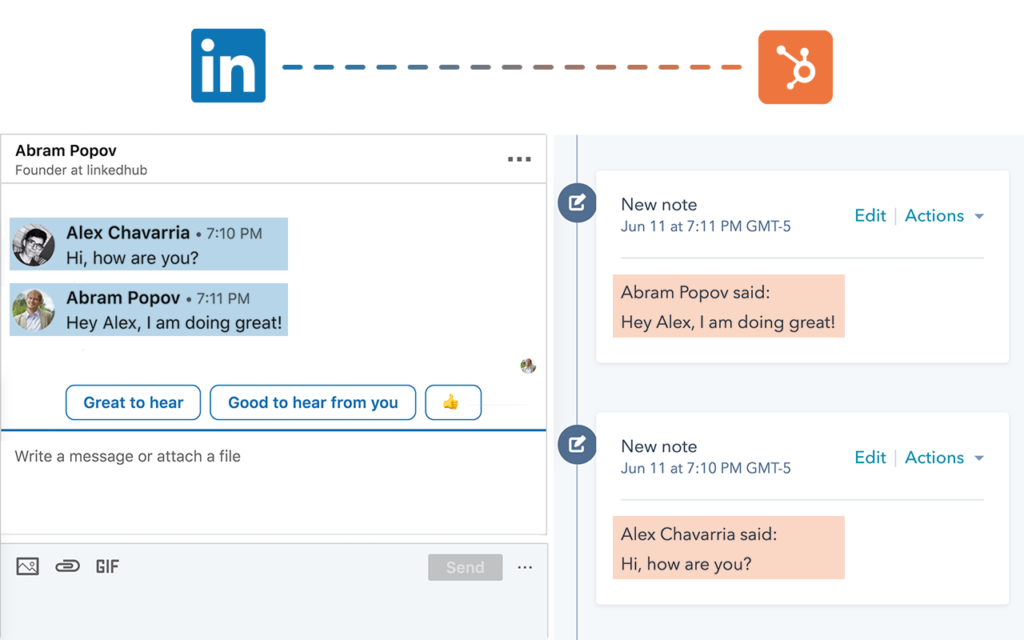
You can use the LinkedHub Chrome extension to sync LinkedIn conversations to HubSpot.
Pros:
- Select which LinkedIn profiles you wish to sync to HubSpot.
- Automatically log messages with chosen profiles to HubSpot.
Cons:
- No official app on the HubSpot platform, but 2,000+ users and stellar reviews should give you enough confidence to try it out.
Sync Facebook Business conversations to HubSpot
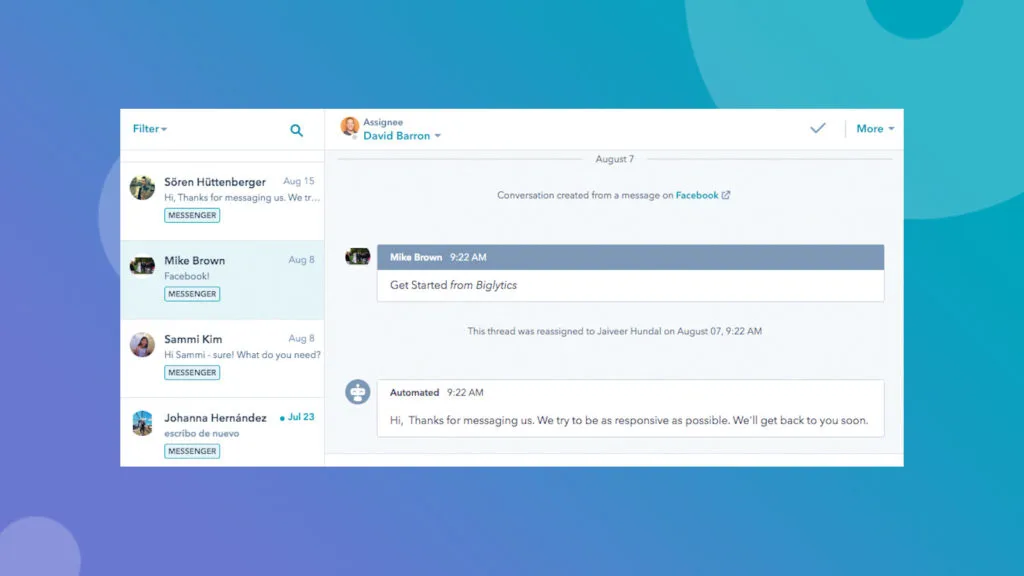
If you have a company page that people sometimes write to, the Facebook Messenger-HubSpot integration will help sure none of these fall through the cracks.
Pros:
- Manage Messenger conversations real-time from HubSpot.
- Create chatbots for your Facebook page, if you think that’s a good idea.
Cons:
- None
6. Ensure smooth calling with calendars, calling software, transcribing integrations
Calling is a key communication channel for salespeople. So, consider using the following calling and call-related integrations to make sure your calls go smoothly.
Easily create calls and meetings with the Outlook/Google calendar integration
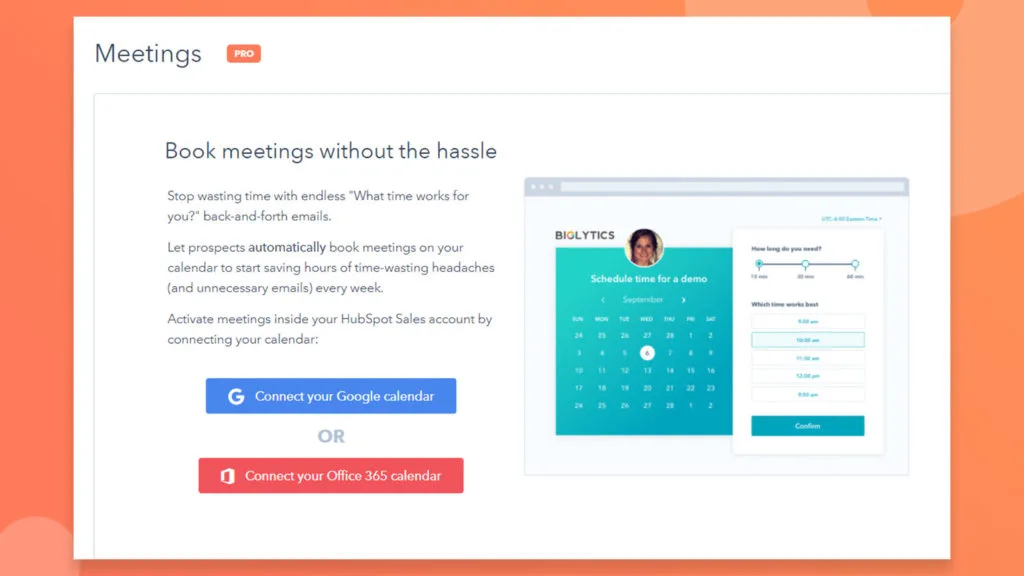
The Outlook and Google calendar integrations with HubSpot work the same, offering two-way integration with HubSpot so you can seamlessly schedule calls and send invites to guests.
Pros:
- Simultaneously log a meeting in your CRM, create a calendar event for that meeting, and send invites to meeting guests.
- Connected with the HubSpot meetings tool, your prospects can book a time that works for both of you, without the back-and-forth of email.
Cons:
- Some reviews say the integration makes the calendar slow.
- The functionality is pretty basic, and does not allow for easy rescheduling, for example.
P.S. Do you use Calendly? You may want to look into setting up a HubSpot-Calendly integration.
Manage calling workflows with the Aircall integration
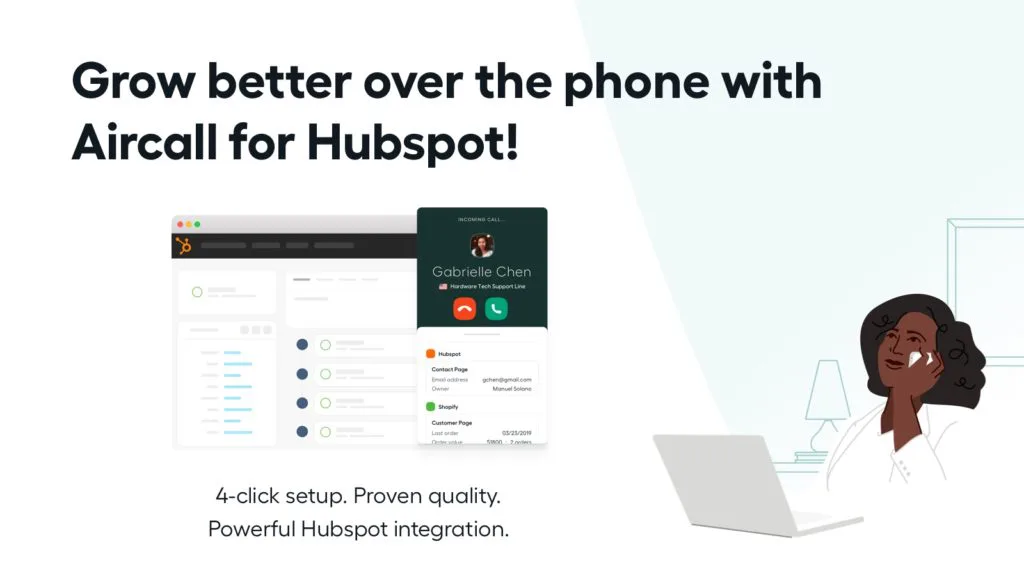
Aircall is a great telephony app for sales and support teams. The Aircall-HubSpot integration creates a cloud-based phone system right inside HubSpot CRM. However, do note it is only useful if you have at least 3 agents or more, as Aircall’s plans do not accommodate teams with fewer agents.
Companies with 50-200 employees that have a lot of sales and support calls can really benefit from it though. See Natan’s review as proof:
Pros:
- Place outbound phone calls inside HubSpot with just a click, or load a list of contacts in the Aircall phone for automatic outbound dialing.
- Your HubSpot contact and deal information is displayed in Aircall’s phone app, before even answering the phone.
- Calls will be logged automatically in the HubSpot timeline of the right contact, along with details like call notes and call recording.
Cons:
- It is quite costly, so only for larger businesses will really benefit
7. Wow your prospects with beautiful proposals and quotes
All your marketing efforts will go to waste if you don’t close the deals, right? If you’re in a field where brand matters, it’s worth putting in extra effort to make your sales materials look top-notch. It will make you stand out and leave a lasting impression.
Create and send impressive sales documents without leaving HubSpot
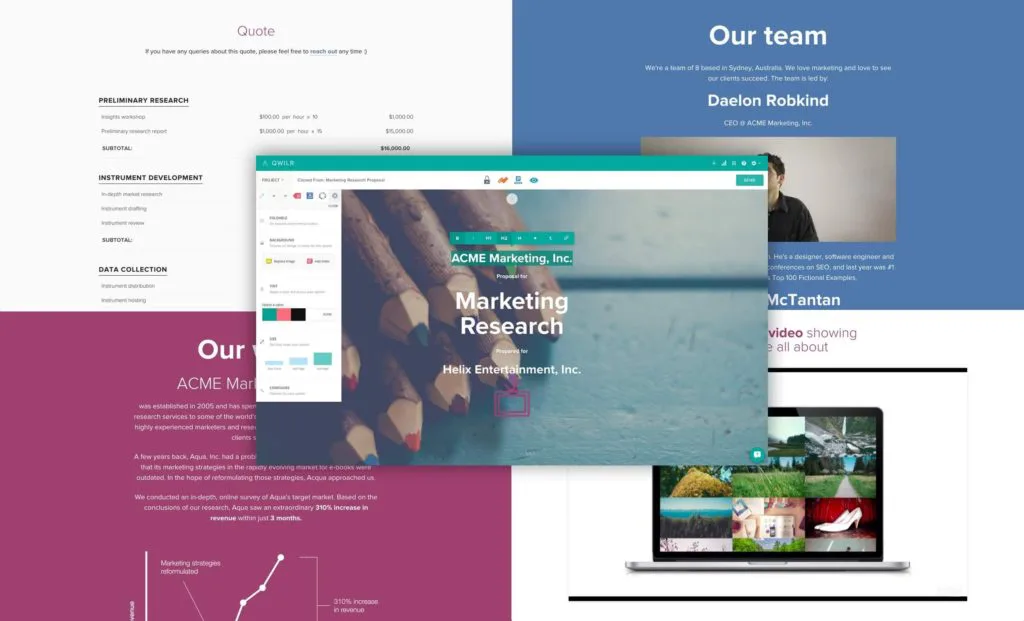
The Qwilr-HubSpot CRM integration may just be the best kept secret on the App Ecosystem. Use it to create, send and track your good-looking sales documents.
Pros:
- Quickly create personalized proposals, quotes and presentations
- See document activity (views and acceptance) right in HubSpot
- Autofill document content with client details from HubSpot
Cons:
- Pricing may be a turn-off if you’re not sending a lot of sales materials
Bonus for eCommerce businesses: Make data management for your eCommerce store easy
If you run a successful eCommerce business, then you know just how much data your systems process. Managing it can get challenging for businesses and this is exactly where using a HubSpot integration can help you.
Integrate and manage your WooCommerce store with ease
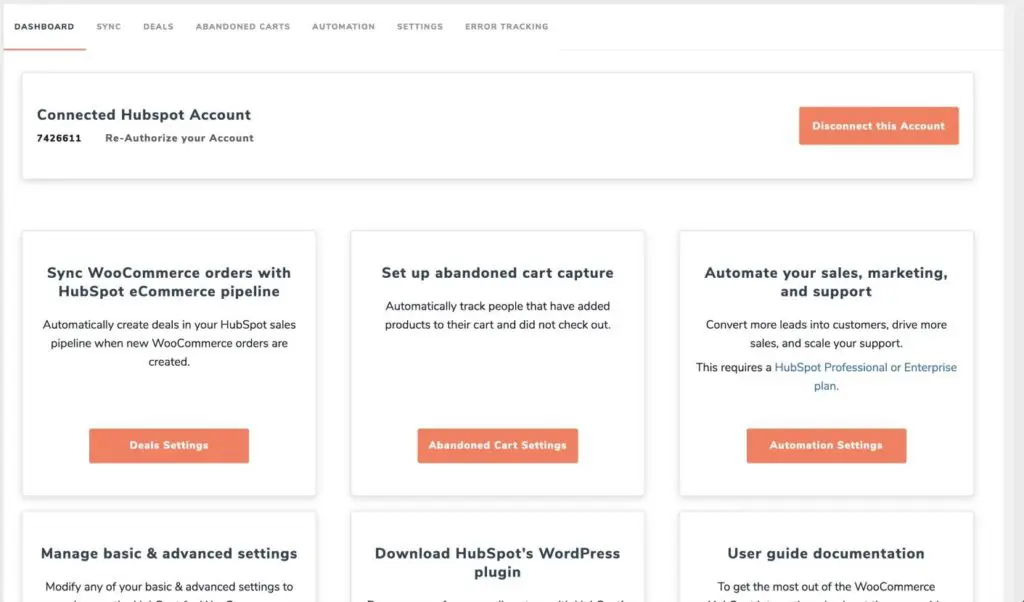
WooCommerce by MakeWebBetter integrates your WooCommerce store with HubSpot. Developed by MakeWebBetter, this app also helps you in data syncing, abandoned cart recovery, sales and marketing automation.
Pros:
- Helps you track and recover abandoned carts with workflows
- Lets you segment users as per their characteristics
Cons:
- Synchronization may take a while if you’ve large amounts of data
Whew, we’re really glad so many tools prioritize building integrations these days, so your developers don’t have to use development resources and build custom integrations.
Now, over to you! Did we miss any great HubSpot integrations that power up marketing and sales productivity? Are you using other tools like Wistia, Pandadoc or Zendesk to power up your HubSpot setup? Let us know in the comments.
Here at Outfunnel, we are all about connecting sales and marketing tools. We’ve already mentioned the Mailchimp, ActiveCampaign and Sendinblue integrations, as well as several web form integrations—our HubSpot-Calendly and HubSpot-Facebook Ads integrations are equally popular.
We are planning to many more useful CRM-marketing integrations in 2022. Below is our current shortlist for HubSpot CRM. Follow the links and sign up for early access, if you’re interested:
Outfunnel is #1 top-rated Pipedrive integration and is now offering affordable marketing integrations for HubSpot CRM users. Try it out with a free 14-day trial today.

